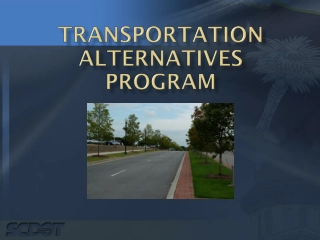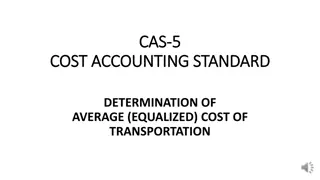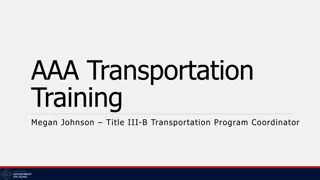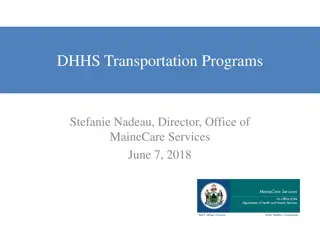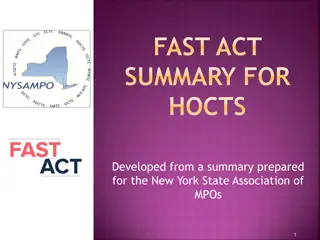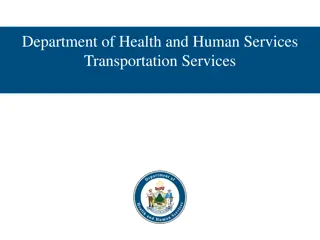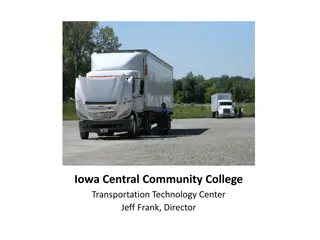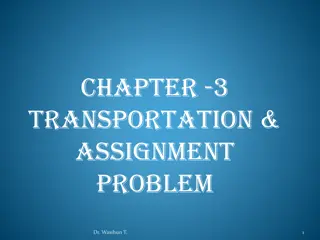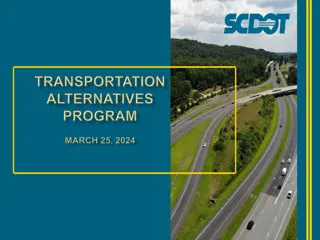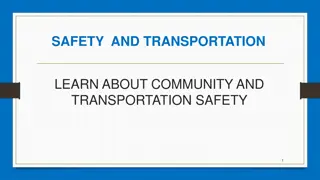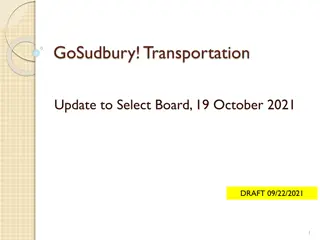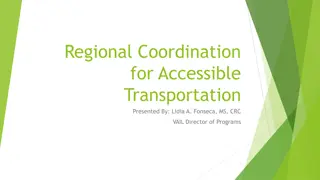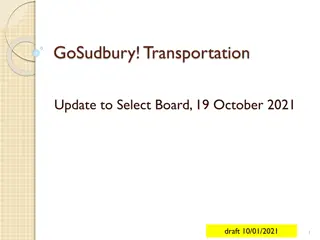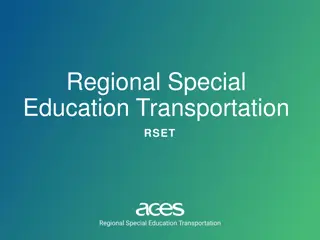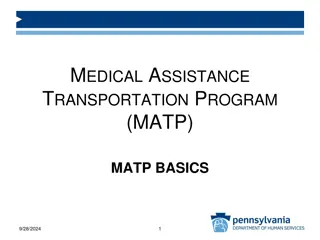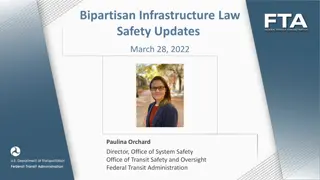Special Transportation Basics for Student Safety
In this article, learn about the training and certification requirements for bus drivers and driver assistants who transport students with disabilities. Discover the general bus driver training curriculum, medical training recommendations, and emergency procedures for ensuring student safety.
Download Presentation

Please find below an Image/Link to download the presentation.
The content on the website is provided AS IS for your information and personal use only. It may not be sold, licensed, or shared on other websites without obtaining consent from the author.If you encounter any issues during the download, it is possible that the publisher has removed the file from their server.
You are allowed to download the files provided on this website for personal or commercial use, subject to the condition that they are used lawfully. All files are the property of their respective owners.
The content on the website is provided AS IS for your information and personal use only. It may not be sold, licensed, or shared on other websites without obtaining consent from the author.
E N D
Presentation Transcript
Special Transportation: The Basics Susan Farra Exceptional Children Consultant Kentucky Department of Education November 21, 2017
Thank you for all you do to keep our students safe! 3
Training Requirements The Individuals with Disabilities Education Act (IDEA) and Section 504 do not specifically address licensing and other requirements that apply to bus drivers who transport students with disabilities. This is also true with regard to driver assistants/bus aides. Rather, these requirements are established by state law and local school district policy. See Letter to McKaig, 211 IDELR 161 (OSEP 1980) (details regarding licensing requirements for drivers employed to transport students with disabilities are a state matter). However, as required by the IDEA regulations at 34 CFR 300.156, the Kentucky Department of Education must establish and maintain qualifications to ensure that personnel (including related services personnel) necessary to carry out the purposes of Part B are appropriately and adequately prepared and trained. Local district policy may impose additional requirements for the training and certification of bus drivers, driver assistants/bus aides. 4
General Bus Driver Training Requirements [702 KAR 5:080 Sections 7 and 8] Section 7: Initial training to become a bus driver shall consist of a training course developed by the Kentucky Department of Education. The core curriculum includes: laws and regulations, driving fundamentals, care and maintenance, critical situations, emergency procedures, pupil management, first aid, extracurricular trips, vehicle operations, vehicle control at speed, and bus route identification This requirement also includes one hour of special education transportation training. Section 8: Prior to the beginning of each school year, each district is responsible for conducting an 8-hour training update relevant to the curriculum for each bus driver based upon the needs of its bus drivers and to ensure student safety. The District must obtain prior KDE approval if it is unable to administer its own update training prior to sending drivers to another district for training. 5
General Medical Training Bloodborne Pathogens First Aid certification is not required for Kentucky School Bus Drivers unless required by district policy only one hour of initial training in First Aid is required Recommended: Cardio Pulmonary Resuscitation (CPR) when possible or if required by district policy 6
Emergency Procedures The training required for bus drivers under 702 KAR 5:080 includes accidents and emergency procedures as well as critical situations and first aid. ****Bus drivers and driver assistants may need additional training in emergency protocol and medical treatment procedures (seizures, medication, etc.) for a child with a disability as dictated in the student s IEP or as offered by the district. 7
Oconee County Sch. Dist. v. A.B., (M.D. Ga 2015) A teen with "profound physical and intellectual disabilities" had a life-threatening condition that required the administration of medication once a seizure reached the five-minute mark. The parent filed for a due process hearing contending that a student needed an aide on the bus to administer medication in the even of a seizure. The district argued that an aide was not needed because the teen was always within five minutes of either home or school. At due process hearing, administrative law judge (ALJ) determined that, in failing to provide an aide for the student, the district created a risk that the student would not receive the medication he needed in the event of a prolonged seizure. The district's director of transportation acknowledged that traffic and weather conditions could affect the provision of timely emergency treatment. The ALJ concluded that this variable presented an unacceptable risk to the student and ordered that the district provide the aide. This amounted to a denial of a Free Appropriate Public Education (FAPE) for the student. The ALJ ordered the district to provide an aide on the bus. The district appealed. The U.S. District Court, Middle District of Georgia upheld the ALJ's ordering the district to provide the teen with an appropriately trained aide. It also upheld the ALJ's order for the district to reimburse the parent 50 percent of her transportation costs. 8
Confidentiality of Student Educational Records The Family Educational Rights and Privacy Act (FERPA) governs the protection, maintenance and destruction of personally-identifiable information contained within student education records. 707 KAR 1:360 Section 8(3) requires that all staff in the district collecting or using personally identifiable information contained in student records, including transportation personnel, receive training or instruction on FERPA requirements. 9
United States Department of Education Office for Civil Rights (OCR) OCR will investigate allegations involving the lack of training of bus drivers and aides. West Genesee (NY) Cent. Sch. Dist., 115 LRP 17584 (OCR 03/09/15) (finding that a district violated Section 504 when it failed to train a bus driver on a student's diabetes plan). 10
Under Part B of the Individuals with Disabilities Act (IDEA) Every eligible child who has a disability and requires special education services will have a written plan called an Individual Education Program or IEP. [707 KAR 1:320] [34 C.F.R. 300.340 and 300.341] An IEP shall include a statement of the specially designed instruction and related servicesand supplementary aids and services that the child will receive in order to receive a free appropriate public education (FAPE). [707 KAR 1: 320 Section 5(8)] [707 KAR 1:290 Section 1] [34 C.F.R. 300.347(a)(3)] 11
Admission and Release Committee Meetings (ARCs) The ARC, with parental input and involvement, makes the decision as to the student s need for special transportation and how it will be implemented. The ARC should sufficiently detail the district s responsibility with regard to the transportation for students with disabilities in the student s IEP. The ARC must meet, , at a minimum at a minimum, annually to review the student s IEP. Under Kentucky regulation, related services personnel are to be invited to ARC meetings when it is appropriate . [707 KAR 1:320 Section 3(g)] When there are concerns or issues connected to special transportation, the Transportation Director should contact the district s Director of Special Education to discuss the need for an ARC meeting. 12
Prince George's County Public Schools, 66 IDELR 203 (SEA MD 2015) The district s decision to inform its transportation staff about a grade schooler's related services through a "route sheet" rather than the student's IEP led to a denial of a Free Appropriate Public Education for the student. This was a formal Maryland state complaint. The route sheet indicated a grade school student required safety vest, but failed to list other requirements contained in the student s IEP. The student s also required a one-to-one bus aide and unaccompanied seating as specified in their IEP, but the Maryland Education Department held that the district s efforts were insufficient as these other accommodations were not reflected in the routing sheet. Corrective Action: The district was required to provide the student compensatory services and to take immediate steps to ensure that all staff members were notified of "all IEP requirements related to each student's identified transportation needs." 13
Colonial Sch. District (SEA DE 2016) Formal State Complaint: Behavior on the Bus The student was 14 years old and identified as having a specific learning disability. While the ARC in this case discussed the student's behaviors and agreed on-the-bus supports were necessary, the committee did not determine which supports the student required. That omission, along with the district's failure to provide any transportation supports, deprived the student of transportation services. The Delaware district also violated the IDEA by removing the student from the regular school bus due to behavioral problems. The investigator noted that district removed the student from the bus for behavioral reasons despite its failure to provide transportation supports that the IEP team had deemed necessary. The student was denied entry when trying to board the bus, and then placed on more restrictive transportation, without receiving the support the student's IEP Team determined the student needed to receive a Free Appropriate Public Education (FAPE). The prior written notice sent to the parent only stated that the student would receive "behavioral supports" for transportation. The complaint investigator pointed out that the vague terms within the PWN forced the parent to guess which services the district intended to provide. The investigator stated the behavior supports deemed necessary by the ARC should have been described and documented with more specificity in the IEP to facilitate implementation. The Delaware Education Department ordered the district to allow the student to ride the regular school bus at the start of the new school year, convene an IEP meeting (ARC) to discuss the supports the student required on the bus, and provide staff training on transportation as a related service. 14
Special Transportation Includes: Transportation to and from school and between schools [34 C.F.R. 300.34(c)(16)(i)] Travel in and around school buildings Community-Based Instruction Field Trips Specialized equipment (special or adapted buses, lifts and ramps) Participation in school and district-offered activities (including nonacademic activities) outside of school hours. 15
Factors to Consider When Determining a Student s Need for Special Transportation ***Overarching Question: Does the student require transportation to benefit from their educational program? Student s mobility (**However, an ambulatory impairment is not necessary to qualify for transportation as a related service under the IDEA.) Student s behavior Student s communication skills Student s physical needs Student s age Student s ability to follow directions Distance the student will need to travel Nature of the area 16
McNair v. Oak Hills Local School District 872 F. 2d 153 (6th Circuit, 1989) U.S. Appeals, Sixth Circuit (binding on Kentucky) Facts: Primary grade student enrolled in private school by her parents. (Parents paid tuition and transported the student to and from the private school.) Student had a hearing impairment which qualified her for a free appropriate public education under the IDEA. Oak Hills was willing to provide the student with an appropriate education at the local public elementary school. The distance from the student s home to the private school was more than two miles. Travel time from the point of pick up to the private school was 34 minutes. The local school district provided free transportation to elementary and primary grade students who were disabled and nondisabled residing in the Oak Hills School District and attending nonpublic schools that are more than two miles from their residences. The parties stipulated that the student s disability did not preclude her from using non- handicapped transportation services. 17
McNair v. Oak Hills Local School District (Facts continued) Parents asked district to provide the student with transportation to and from the private school. Oak Hills School District refused. Due Process Hearing: Hearing officer ordered Oak Hills to transport the student to and from the private school. Oak Hills appealed. Review Officer ruled that district was not obligated to provide the transportation because (1) the student s disability did not prevent her from using non- handicapped transportation services and (2) travel time between her home and school was more than 30 minutes. Parents appealed to the district court. District Court Magistrate concluded district was only required to provide related services necessary to permit the student to benefit from special education, and transportation was NOT a related service in her situation. District Court adopted the magistrate s recommendation, but under different reasoning. District Court said that, under the IDEA, related services are those services provided through state-financed and controlled special education programs, and the private school did not qualify as special education. Parents appealed to the Sixth Circuit. 18
McNair v. Oak Hills Local School District 872 F. 2d 153 (6th Circuit, 1989) Sixth Circuit Unique Needs Test Four factors to determine whether the student should receive special transportation. Court said 20 U.S.C. Section 1400(c) requires: 1. that the student is handicapped ; 2. that transportation is a related service; 3. that the related service is designed to meet the unique needs of the child caused by the handicap; and, 4. the school district must be responsible under the EHA (IDEA) and its regulations for providing the related services under the particular circumstances at hand. 19
McNair Holding The Sixth Circuit held that the third part of the test was not met because the student s unique needs cause by her disability were not such that she needed special transportation as a related service. As a result, Oak Hills School District was not required to transport the student to and from the private school. 20
When Considering a Students Transit Time and Distance For some students with disabilities, a lengthy travel time can adversely effect a student s performance in terms of energy level, concentration abilities and in many other ways unique to their disability. It is important that the student s ARC consider these factors when developing the student s IEP when designating the amount of time to be spent on the bus. The ARC should also consider the age and disability of the student when determining whether or not the travel time will have a detrimental effect on the student. Travel time cannot be counted as instructional time and cannot be used to reduce the length of the school day. 21
Least Restrictive Environment (LRE) While not specifically addressed in the IDEA, the U.S. Department of Education has said, It is assumed that most children with disabilities will receive the same transportation provided to nondisabled children, consistent with the LRE requirements in 34 C.F.R. 300.114 through 34 CFR 300.120, unless the IEP team determines otherwise. 71 Fed.Reg. 46,576 (2006) 22
Least Restrictive Environment Factors to Consider: Can regular transportation be effectively and appropriately implemented with supplemental aids and services aids and services? Do the advantages of the student riding in regular transportation outweigh the benefits of a more restrictive transportation arrangement? Are there any negative effects to the student or other students on the vehicle if the student rides in regular transportation? with supplemental 23
LRE under Section 504 and the ADA Unless there is a legitimate, nondiscriminatory reason for it, requiring students with disabilities to ride in segregated special education buses likely violates Section 504 and the ADA. Section 504 and Title II of the ADA generally prohibit separate transportation services for students with disabilities unless such separation is necessary due to a student s disability. 24
Extracurricular Activities The IDEA and Kentucky Special Education Regulation require districts to provide transportation as a related service for extracurricular or nonacademic activities when the student with a disability requires that service in order to benefit from special education. 71 Fed. Reg. 46,576 (2006) 71 Fed. Reg. 46583 (2006) 707 KAR 1:290 Section 5(3) When an ARC includes an extracurricular activity as part of a student s special education program, it becomes part of the student s required program, and the district must provide transportation as a related service. Section 504 also requires districts to provide transportation services that allow the student an equal opportunity to participate in extracurricular activities 25
Kennedy v. Board of Educ., McDowell County, 337 S.E. 2d 905 (W. Va. 1985) Two families, each having a child with spina bifida, lived on an unpaved, mountain road that were owned by timbering company and not part of the state road system. The homes of the two students were located more than half a mile from the proposed district bus stop. The students were unable to walk to the bus stop and parents were unable to transport them on a regular basis. Transportation was not provided during the 1984-85 school year, and the students received homebound instruction. The West Virginia Court of Appeals ordered the school district to provide the transportation to and from the students homes. The district had to purchase a special vehicle to reach the students because the regular school bus could not use the unpaved mountain roads. 26
Other Special Transportation Cases Los Angeles Unified Sch. District., (SEA CA 6-20-2016) A California district did not have to provide a 6-year old with OHI, ADHD, and hearing impairment door-to-door transportation simply because his mother preferred it. During a due process hearing, an administrative law judge ruled that the district provided the student appropriate transportation services by assigning a bus aide to meet the boy and escort him to the bus. Missouri Schs. for the Severely Disabled (SEA MO 2016) Although a bus stop at the curb of a student s home did not violate state or local traffic laws, the dangerous driving conditions in the area made it an inappropriate place to pick up and drop off the student. The Missouri Education Department determined that the district s failure to provide door-to-door transportation under the circumstances deprived the student of a Free Appropriate Public Education. McComb Local Sch. Dist., (SEA OH 2016) A district s failure to modify a student s transportation arrangements following a change in residence amounted to an IDEA violation, the Ohio Education Department determined. Noting that the 26-mile bus ride each morning and afternoon impeded the student s learning, the Education Department instructed the district to revise the student s IEP as soon as possible. 27
Restraint and Seclusion Districts must be careful not to restrain or seclude students in a way that constitutes disability discrimination or denies the student FAPE. (Dear Colleague Letter: Restraint and Seclusion of Students with Disabilities, OCR, 2016) Districts should b e careful not to seclude students with disabilities for behavior that would not result in the seclusion of nondisabled students. Distinguish between restraints used for physical safety and restraints used for behavior management. The appropriateness of a restraint depends on how it is used and if the student s behavior raises significant safety concerns. P.T. v. Jefferson County Board of Education (11th Cir., 2006): District was permitted to use a safety harness on a student with autism on the bus because her violent behavioral outbursts posed a threat to the driver and other passengers. OCR excludes the following from its definition of aversive restraints: Adaptive devices or mechanical supports used to achieve proper body position, balance or alignment Vehicle safety restraints during the transport of a student in a moving vehicle 28
Repeated use of restraint is a.. Red flag!!! 29
Dos and Donts of Restraints (Hildebrant, Disability Rights Ohio, LRP Publications) Only use physical restraint in an emergency where the student is in danger or is a danger to themselves or others. Don t use restraint as a punishment. The use of a mechanical restraint (such as a safety harness) by itself is not an appropriate behavior management technique. Don t discriminate against students with disabilities by using restraint in situations where you wouldn t restrain nondisabled students. Appropriately train bus staff who must employ mechanical or physical restraints. 30
Service Animals 702 KAR 5:080 Section 14(2)(a) states: While the transportation of live animals is generally prohibited on a school bus, a service animal may be allowed if the need is supported through medical evidence or the student s IEP and is not a risk to other riders. 31
How Can I Get Help? Bus drivers and driver assistants/monitors should first share concerns with the school principal and district s transportation director for guidance. When a transportation or safely issue involves a student with an IEP or 504 plan, the district s transportation director should consult with the district s special education director (Is an ARC meeting needed or appropriate?) If still unsure how to proceed, contact the local educational cooperative (see upcoming slide for contact information) or contact the Division of Learning Services at (502) 564-4970. 32
Resources Special Education Cooperatives Kentucky has a host of educational cooperatives that provide assistance and expertise for the benefit of their member school districts. The cooperatives provide comprehensive educational services and programs that support the member districts and their schools in their school improvement efforts. Have consultants available who can assist with training in special education, related service requirements and positive behavioral intervention strategies https://education.ky.gov/comm/about/Pages/Kentucky-Education-and- Special-Education-Cooperatives.aspx 33
Resources o Family Educational Rights and Privacy Act (FERPA) o http://education.ky.gov/districts/SHS/Pages/M edication-Administration-Training-Program.aspx o http://education.ky.gov/districts/trans/Pages/ Driver-Trainer-Training.aspx o http://education.ky.gov/districts/trans/Pages/ Training.aspx 34
More Resources Transporting Students with Disabilities and Special Needs (newsletter/periodical); Published by PaperClip Communications, Inc. National Association of Pupil Transportation Committee on Special Needs Transportation 1840 Western Avenue Albany, NY 12203 Toll Free: 800.989.NAPT (6278) Tel: 518.452.3611 Fax: 518.218.0867 Email: info@napt.org Current Chair: Dr. Linda F. Bluth Current Co-Chair: Dr. Peter Lawrence, CDPT . 35
Again, thank you for keeping our students safe! 36
??? Questions ??? Susan Farra susan.farra@education.ky.gov (502) 564-4970 (Ext. 4136) 37
Roles of a Special Transportation Driver https://www.youtube.com/watch?v=_4HbLwYk4xQ 38
Roles and Responsibilities Special Education Monitor/Driver s Assistant https://www.youtube.com/watch?v=q8BBD GcnVZk 39


